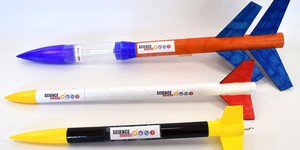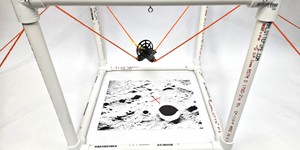Seventh Grade, Space Exploration Science Projects (25 results)
Space exploration is an exciting and wide-ranging area. Getting into space (and back down) is hard, involving rockets and launch vehicles, satellites, spacecraft, re-entry systems, landers and rovers, robots, and orbital mechanics, not to mention hypothetical technologies like space elevators and artificial gravity. To survive and thrive in space, we must understand many additional issues such as human performance in space, the space economy, and the science of astronomical bodies.
|
Select a resource
Coding Projects
Sort by
|
3... 2... 1... 0— blastoff! In this science project, you will use a bottle rocket launcher to launch your own bottle rocket. You will load it with water and pressurized air, make several launches, and find out what makes your rocket soar the highest.
Read more
How does a parachute work? Do bigger parachutes work better than smaller parachutes? Find out in this science project if the size of the parachute matters.
Read more
New
Have you ever seen a waiter balance an entire tray of drinks without spilling any? How do they do it? Do you think you could build a robot waiter that can do the same thing? In this project, you will learn how to build a self-balancing robotic tray. You can incorporate the auto-leveling tray into one of our many other robotics projects, like the Bluebot or robotic arm.
Read more
Inspired by real-world reusable rockets, in this engineering challenge, you will design and build a device to catch a falling rocket so it lands vertically. Drop the rocket from higher and higher heights to get a better score! The 2025 Science Buddies Engineering Challenge is over, but you can check out this page to see our other past engineering challenges and what this year's challenge will be! Teachers, lesson plan versions of this challenge are also available.
Read more
Rockets are definitively an engineering challenge. These amazing gravity-defying machines have lifted test material, people, and even animals into space. Feel like building one yourself? In this science project, you will transform a water bottle into an aerodynamic bottle rocket with two compartments, one for the fuel and one for a payload. You will then test how well it performs when lifting mass vertically up into the air. Ready, set, soar!
Read more
Why do the planets orbit the sun without flying off into space? Do they move in perfect circles or do their orbits take a different shape? And how could you possibly do a science project about any of this—you can't do an experiment with the planets! However, you can build a model of our solar system that demonstrates the concept of gravity, using balls of different sizes to represent the sun and planets. Watch the summary video for an excellent introduction to the model.
Think about how…
Read more
New
Have you ever walked next to your favorite ocean, lake, or creek and seen plastic waste everywhere? Have you ever thought about how much plastic breaks down into microplastics and pollutes waterways? Scientists are coming up with new ways to remove these microplastics from our waterways, and now you can test them out for yourself at home.
Read more
What keeps a model rocket on course? How can you make sure a model rocket design is stable before you launch it? Find out in this project as you learn about center of mass, center of pressure, and their effect on a rocket's stability.
Read more
How do you make a spacecraft land safely on the Moon or another planet like Mars? It probably helps to know how far away the ground is so you can deploy landing gear, activate a parachute, or fire thrusters to help slow down. In this project you will build your own "lander" vehicle with a sensor that can measure distance to the ground, allowing you to program outputs like blinking lights or an audible alarm.
Read more
Companies like SpaceX and Blue Origin are dramatically lowering the cost of space flight by designing reusable rocket boosters that land back on Earth. Getting a rocket to land vertically without any damage - and without using a parachute to slow it down - is quite a tricky physics problem! In this project you will modify your own model rocket so it can land vertically.
Read more
What does it take to launch a robot to Mars or for a satellite to explore our outer solar system? In this project you will explore the physics of a rocket as you predict its performance, launch it, and measure the actual results. This is rocket science!
Read more
How do you practice landing a spacecraft on another planet or docking it with a space station? With a spacecraft motion simulator here on Earth! In this engineering project, you will design and build your own cable-driven spacecraft motion simulator that lets you move a model spacecraft around in three-dimensional space.
Read more
|


















